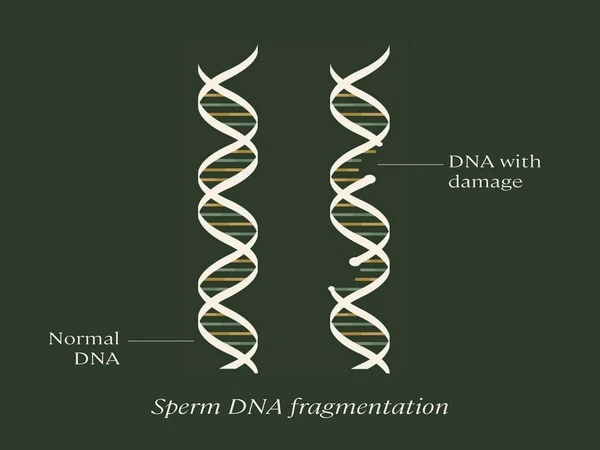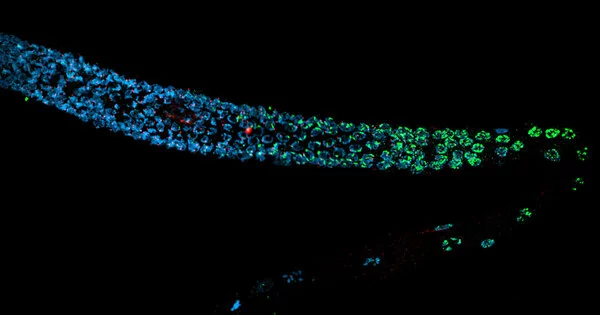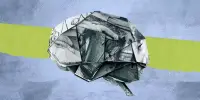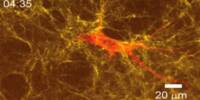Damage to the nematode Caenorhabditis elegans’ paternal genome cannot be repaired and is instead passed on to its offspring, whereas the female egg repairs or limits the damage. Whether radiation exposure by fathers can have consequences on their children is one of the most long-standing questions in radiation biology. Using the nematode Caenorhabditis elegans as a model, Professor Dr. Björn Schumacher and his team discovered that radiation damage to mature sperm cannot be repaired but is instead passed on to the offspring.
In contrast, female eggs either accurately repair the damage or, if the damage is too severe, are eliminated and no damage is passed on. However, when the egg is fertilized with a sperm that has been damaged by radiation, the maternal repair proteins that are provided by the egg try to repair the paternal DNA.
A highly error-prone repair mechanism is used for this purpose, which randomly fuses the broken DNA pieces. These random break fusions cause structural changes in the paternal chromosomes. The resulting offspring now carry the chromosome damage, and their offspring have severe developmental defects. The C. elegans research lays the groundwork for a better understanding of the mechanisms underlying the heritable effects of paternal radiation exposure.
This work has now been published under the title ‘Inheritance of paternal DNA damage by histone-mediated repair restriction’ in Nature.
Genome aberrations, especially structural variations in chromosomes, which develop in the paternal germline, are thought to increase the risk of disorders like autism and schizophrenia. Such damage could potentially be inflicted during radiotherapy or chemotherapy and thus pose a risk in the two months that it takes to generate new sperm to replace the damaged one.
Professor Dr. Björn Schumacher
The offspring that result from male animals that have been exposed to radiation and healthy female worms carry on the so-called structural variations – random connections of chromosome parts. In the offspring, these aberrations lead to recurrent breaks but this damage can no longer be repaired. Instead, the damaged chromosomes are shielded from accurate repair by proteins, so-called histones, that densely pack the long strands of DNA. In the densely packed DNA, the breaks can no longer be reached by the repair proteins.
The packed DNA structures are held tightly together by the specific histone proteins, HIS-24 and HPL-1. When those histone proteins are removed, the paternally inherited damage is completely eliminated and viable offspring can be produced. The finding that histone proteins govern the accessibility of DNA for repairs could provide effective therapeutic targets for treating radiation damage.

Is this also relevant to radiation damage in humans? In addition to the work on nematodes, the team detected the same structural variants, or randomly assembled chromosomes, in humans. Also here, the chromosome aberrations were specifically passed on from the fathers but not the mothers. For this, the scientists analyzed various data sets from the 1000 Genome Project which contains genetic data from more than a thousand people, and the Islandic deCODE project with genetic data from the respective mothers, fathers, and children.
“Genome aberrations, especially structural variations in chromosomes, which develop in the paternal germline, are thought to increase the risk of disorders like autism and schizophrenia,” Schumacher said. This means that also in humans, mature sperm needs to be especially protected from radiation damage, and damaged mature sperm should not be used for conception. He added, “Such damage could potentially be inflicted during radiotherapy or chemotherapy and thus pose a risk in the two months that it takes to generate new sperm to replace the damaged one.” This is because in contrast to mature sperm, newly generated sperm have the capacity to accurately repair the damage.
Interestingly, the scientists found those structural variations in the chromosomes also in nematodes in the wild and in the human population. These results suggest that damage to mature sperm and the inaccurate repair of paternal DNA in the zygote could be major drivers for genetic diversity during evolution and might be responsible for genetic diseases in humans.
















